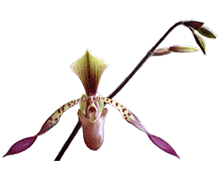How to Identify an Orchid
This pictorial shows examples of orchids and identifies the type of orchid. You can use this guide when repotting an orchid that has no label and if you are unsure which genera it is. The following orchids are commonly sold in nurseries, groceries and box stores and are sometimes sold with no label other than simply "orchid".
See all of our How to Care for Orchids, How to Repot an Orchid and Videos on Orchid Care.
The most common orchids found for sale are Phalaenopsis, Dendrobium and Oncidium.
Brassavola
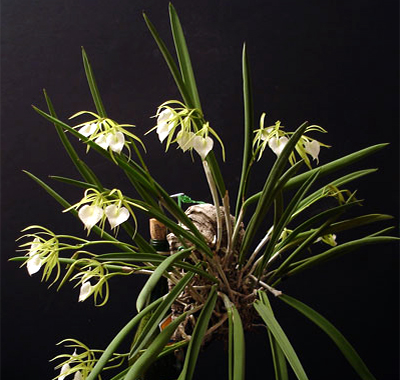
 The "lady of the night" orchid, so named for its delightful fragrance in the evening is
a wonderful addition to any orchid collection. It has stout terete leaves which emerge along a central rhizome.
From the new growth comes elegant white flowers in early winter. When the sun goes down, the fragrance emerges to fill the entire room. Brassavola can be grown on an orchid mount or in a pot. Gallery Photo
The "lady of the night" orchid, so named for its delightful fragrance in the evening is
a wonderful addition to any orchid collection. It has stout terete leaves which emerge along a central rhizome.
From the new growth comes elegant white flowers in early winter. When the sun goes down, the fragrance emerges to fill the entire room. Brassavola can be grown on an orchid mount or in a pot. Gallery Photo
Catasetum
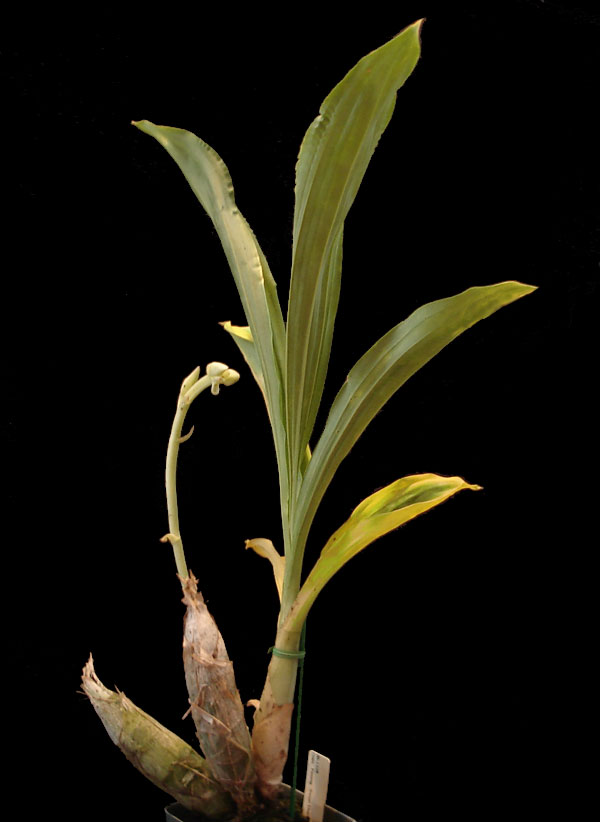
 Catasetum are unique and most unusual orchids. Deciduous in nature, they require a distinct winter dry rest.
When they bloom the large waxy flowers will be either male or female. The male flowers are typically showier and are produced at lower light than required for female flowers.
If the flower is bumped the pollen is literally ejected into the air.
Catasetum are unique and most unusual orchids. Deciduous in nature, they require a distinct winter dry rest.
When they bloom the large waxy flowers will be either male or female. The male flowers are typically showier and are produced at lower light than required for female flowers.
If the flower is bumped the pollen is literally ejected into the air.
Cattleya
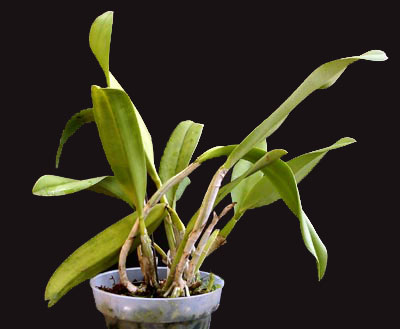
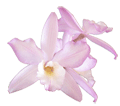 The corsage orchid is a popular and rewarding orchid to grow. It has large tall growths called pseudobulbs that are topped with a leaf growing one after another to produce the next season's bloom. The pseudobulbs are connected to each other by a horizontal growth that is at or just under the surface of the media called a rhizome. When repotting, a rhizome clip may be required to secure the orchid in its pot. Cattleya orchids are usually repotted when they have finished blooming and a new pseudobulb is just starting to grow. Gallery Photo
The corsage orchid is a popular and rewarding orchid to grow. It has large tall growths called pseudobulbs that are topped with a leaf growing one after another to produce the next season's bloom. The pseudobulbs are connected to each other by a horizontal growth that is at or just under the surface of the media called a rhizome. When repotting, a rhizome clip may be required to secure the orchid in its pot. Cattleya orchids are usually repotted when they have finished blooming and a new pseudobulb is just starting to grow. Gallery Photo
Miniature Cattleya
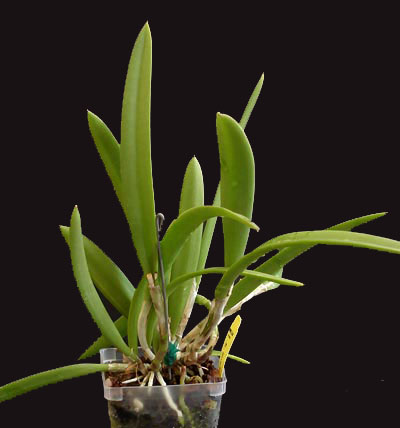
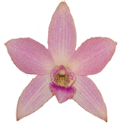 The miniature cattleya is a fraction of the size of its big brother, the Cattleya. Often less than 8" tall, the mini cattleya takes far less space than the standard cattleya which is twice as tall and requires a much larger pot. The miniature cattleya have multiple petite blooms that look remarkably like cattleya blooms except for their smaller size. The miniature cattleya has the same pseudobulb growth habit as the standard cattleya and is best repotted right after blooming as the new growth begins to emerge. We will usually select a smaller media size for our miniature cattleya, potting them in a seedling mix.
The miniature cattleya is a fraction of the size of its big brother, the Cattleya. Often less than 8" tall, the mini cattleya takes far less space than the standard cattleya which is twice as tall and requires a much larger pot. The miniature cattleya have multiple petite blooms that look remarkably like cattleya blooms except for their smaller size. The miniature cattleya has the same pseudobulb growth habit as the standard cattleya and is best repotted right after blooming as the new growth begins to emerge. We will usually select a smaller media size for our miniature cattleya, potting them in a seedling mix.
Cycnoches
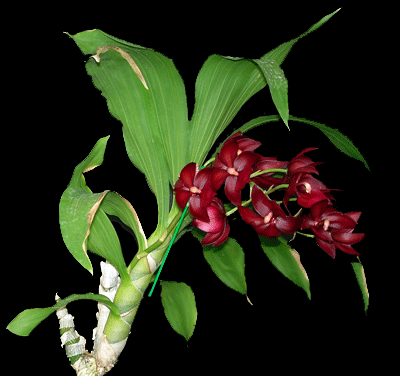
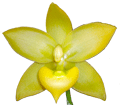 A member of the Catasetum tribe, the waxy and fragrant blooms of Cycnoches are a delight in the early fall. The care for these wonderful orchids is similar to Catasetum including a dry winter rest. From tall pseudobulbs and leaves that lean forward in a fan shape comes an arching inflorescence of blooms with incredible substance. Yellows, reds, greens, they are all a wonderful addition to any collection. They bloom early in the fall, basically in late summer, when not much else is happening. What a delight!
A member of the Catasetum tribe, the waxy and fragrant blooms of Cycnoches are a delight in the early fall. The care for these wonderful orchids is similar to Catasetum including a dry winter rest. From tall pseudobulbs and leaves that lean forward in a fan shape comes an arching inflorescence of blooms with incredible substance. Yellows, reds, greens, they are all a wonderful addition to any collection. They bloom early in the fall, basically in late summer, when not much else is happening. What a delight!
Cymbidium
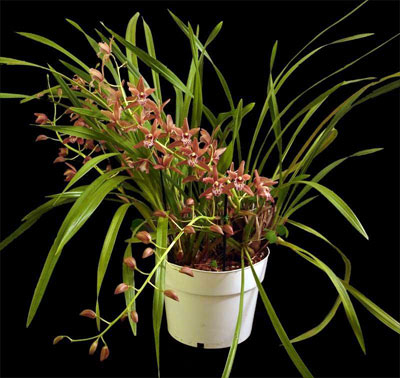
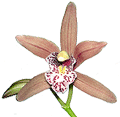 Often large, hairy and unruly, the Cymbidium orchid delights with tall spikes loaded with flowers. This pictured plant is about three feet tall and ready to go into the next size container. The Cymbidium orchid has much smaller pseudobulbs that are topped with long thin leaves that gently drape to form an attractive foliage plant. In warm climates Cymbidiums grow outdoors year-round and spread out to be quite spectacular. Similar to most other orchids, Cymbidiums prefer to be repotted shortly after blooming as the new growth is beginning to emerge.
Often large, hairy and unruly, the Cymbidium orchid delights with tall spikes loaded with flowers. This pictured plant is about three feet tall and ready to go into the next size container. The Cymbidium orchid has much smaller pseudobulbs that are topped with long thin leaves that gently drape to form an attractive foliage plant. In warm climates Cymbidiums grow outdoors year-round and spread out to be quite spectacular. Similar to most other orchids, Cymbidiums prefer to be repotted shortly after blooming as the new growth is beginning to emerge.
Miniature Cymbidium
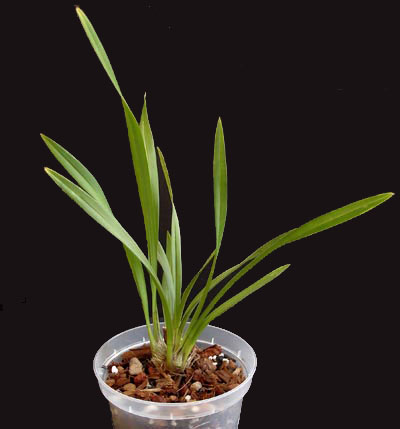
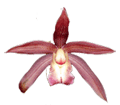 Miniature Cymbidiums are a mere fraction of the size of their standard counterparts making them a workable alternative for growing inside the home.
Miniature Cymbidiums are a mere fraction of the size of their standard counterparts making them a workable alternative for growing inside the home.
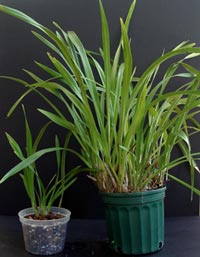
Dendrobium
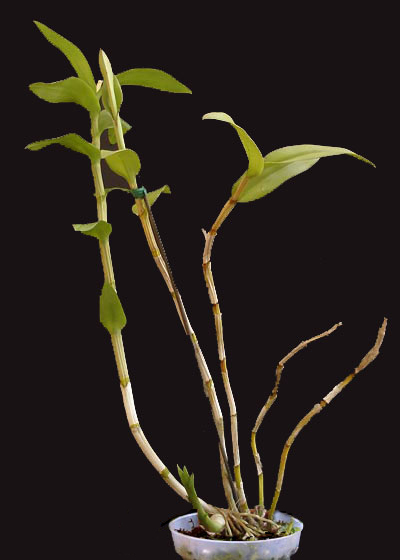
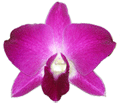 Dendrobiums are tall and stately with elongated pseudobulbs topped by modest sized leaves. Their graceful sprays of flowers are a welcome break during winter's grey days. Even after the leaves fall from the oldest pseudobulbs they continue to provide sustenance to the plant and should be retained during repotting unless they are quite shriveled.
Dendrobiums are tall and stately with elongated pseudobulbs topped by modest sized leaves. Their graceful sprays of flowers are a welcome break during winter's grey days. Even after the leaves fall from the oldest pseudobulbs they continue to provide sustenance to the plant and should be retained during repotting unless they are quite shriveled.
Dendrobiums like to grow in a very small pot, often the pot looks ridiculously small compared to the height of the plant. This presents some unique problems with growing Dendrobiums; they are top-heavy. Some solutions to this are to plant them in clay pots or to use broken brick, cobblestone or pea gravel in the bottom of the pot to weigh it down. Precise staking of Dendrobiums to make them well balanced is also critical.
Dendrobiums often resent repotting and in extreme cases can be killed if repotted at the wrong time. Repot only when new growth begins to appear as in the picture shown at right. Gallery Photo
Recommended Dendrobium Potting Mix:Miniature Dendrobium
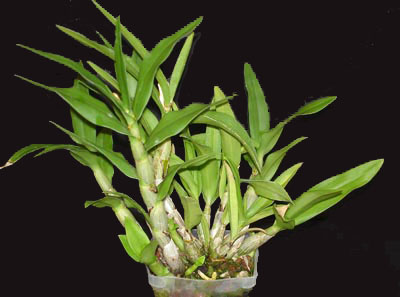
 A delightful and floriferous orchid, a common variety is a Dendrobium Bigibbum hybrid. Small in stature yet covered with blooms, these miniature dendrobiums are a pleasure to grow. Care is similar to standard Dendrobiums yet they are not top-heavy and often don't require staking. Miniature Dendrobiums are about 8 inches tall compared to standard Dendrobiums which can easily exceed 3 feet for a mature plant.
A delightful and floriferous orchid, a common variety is a Dendrobium Bigibbum hybrid. Small in stature yet covered with blooms, these miniature dendrobiums are a pleasure to grow. Care is similar to standard Dendrobiums yet they are not top-heavy and often don't require staking. Miniature Dendrobiums are about 8 inches tall compared to standard Dendrobiums which can easily exceed 3 feet for a mature plant.
Epidendrum
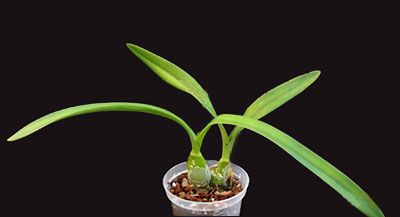
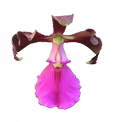 Delicate fragrant blooms atop chunky rounded pseudobulbs, the epidendrum is a delightful orchid. It's high light requirements, however, can make it difficult to rebloom in the home. Supplemental artificial light or summers outdoors help meet its needs. Gallery Photo
Delicate fragrant blooms atop chunky rounded pseudobulbs, the epidendrum is a delightful orchid. It's high light requirements, however, can make it difficult to rebloom in the home. Supplemental artificial light or summers outdoors help meet its needs. Gallery Photo
Reed Stem Epidendrum
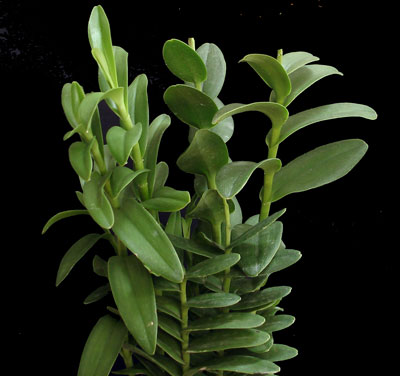
 The Reed Stem Epidendrum has multiple growths each with several leaves. From the top of the growths come
spikes that are topped with a puff ball of delightful little blooms. The blooms may resemble little clown faces.
The Reed Stem Epidendrum has multiple growths each with several leaves. From the top of the growths come
spikes that are topped with a puff ball of delightful little blooms. The blooms may resemble little clown faces.
These orchids are relatively easy to grow and bloom. They prefer to be repotted after blooming. Gallery Photo
Recommended Reed Stem Epidendrum Potting Mix:Encyclia
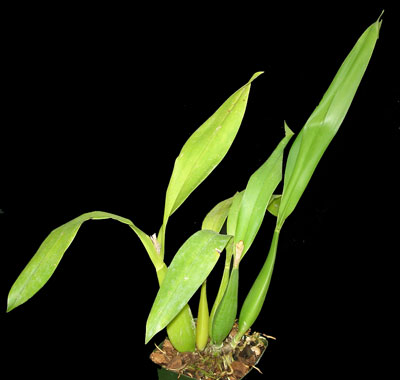
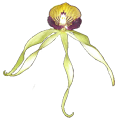 The cockleshell orchid has wispy blooms topped with a dorsal sepal that looks like a seashell. Spikes come from the
top of the pseudobulbs in the winter or early spring. Blooms open successively along the spike allowing the encyclia to stay in bloom for a long time.
The cockleshell orchid has wispy blooms topped with a dorsal sepal that looks like a seashell. Spikes come from the
top of the pseudobulbs in the winter or early spring. Blooms open successively along the spike allowing the encyclia to stay in bloom for a long time.
The Encyclia orchid prefers to be repotted when a new pseudobulb is beginning to grow. Gallery Photo
Recommended Encyclia Potting Mix:Intergeneric Orchids
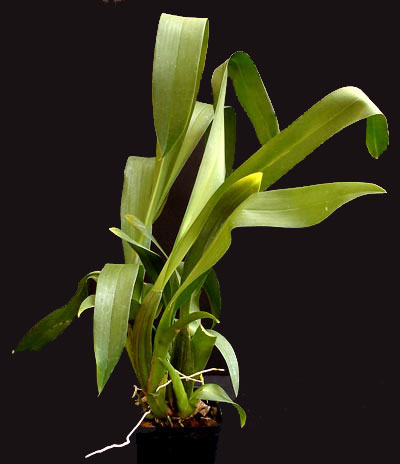
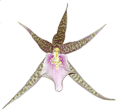 When several different genera are crossed together, the result is called an Intergeneric. These orchids often have very striking and unusual flowers as a result of creative man-made combinations.
When several different genera are crossed together, the result is called an Intergeneric. These orchids often have very striking and unusual flowers as a result of creative man-made combinations.
Intergeneric orchid care and background can be generalized as similar to Oncidiums. For a precise guide to their care one must research the parents. Given all the hybridization that has occurred, however, many of the idiosyncrasies of the parent's culture often has been bred out of these plants.
Like most orchids, Intergenerics prefer to be repotted after blooming as new growth emerges. They also prefer to be in a fairly tight pot. Gallery Photo
Recommended Intergeneric Orchid Potting Mix:Lycaste
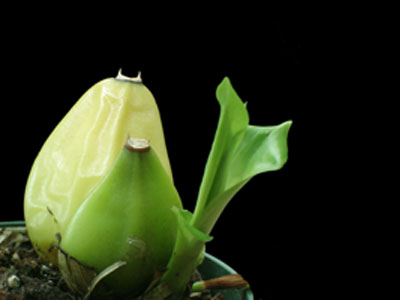
 Lycaste orchids have waxy flowers over fat oval pseudobulbs with wide pleated leaves. Many species are fragrant ranging from lemony scented to cinnamon spicy and many are deciduous, blooming on leafless pseudobulbs. Lycaste prefer a seedling grade mix.
Lycaste orchids have waxy flowers over fat oval pseudobulbs with wide pleated leaves. Many species are fragrant ranging from lemony scented to cinnamon spicy and many are deciduous, blooming on leafless pseudobulbs. Lycaste prefer a seedling grade mix.
Ludisia
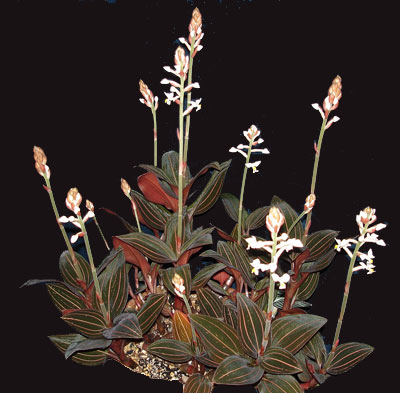
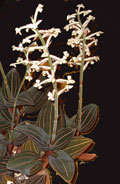 Ludisia Discolor, the "Jewel Orchid" has extraordinary foliage. Grown more for its leaves than for its diminutive flowers, this orchid is often found growing as a common houseplant. Ludisia grows very quickly once established. It is a terrestrial orchid that prefers a fast draining soil-less potting mix like our Jewel Orchid Mix.
Ludisia Discolor, the "Jewel Orchid" has extraordinary foliage. Grown more for its leaves than for its diminutive flowers, this orchid is often found growing as a common houseplant. Ludisia grows very quickly once established. It is a terrestrial orchid that prefers a fast draining soil-less potting mix like our Jewel Orchid Mix.
Masdevallia
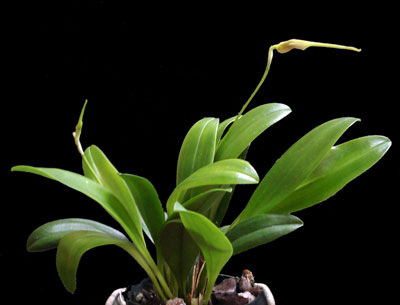
 Masdevallia blooms are strikingly unique. Three fused sepals form a triangular shape hiding the petals and lip from view. Ordinary looking leaves top tiny pseudobulbs making this orchid look much like a common houseplant when not in bloom. These miniature orchids are a pleasure to grow and bloom in the summer when not much else is happening in an orchid collection. Gallery Photo
Masdevallia blooms are strikingly unique. Three fused sepals form a triangular shape hiding the petals and lip from view. Ordinary looking leaves top tiny pseudobulbs making this orchid look much like a common houseplant when not in bloom. These miniature orchids are a pleasure to grow and bloom in the summer when not much else is happening in an orchid collection. Gallery Photo
Miltonia
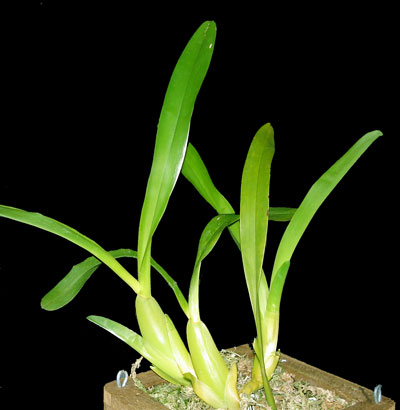
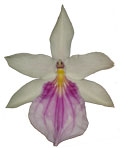 Miltonia, is a wonderful spring to summer blooming orchid. These orchids bear a string of flowers that seem almost too large for the size of their foliage. Sometimes referred to as the 'pansy orchid' it is Miltonopsis that has the real broad pansy-like faces. Miltonia are more warm tolerant and easier to grow than the cooler growing Miltonopsis, though the two are often confused. Miltonia like to be kept evenly moist and prefer a free draining mix or sphagnum moss.
Miltonia, is a wonderful spring to summer blooming orchid. These orchids bear a string of flowers that seem almost too large for the size of their foliage. Sometimes referred to as the 'pansy orchid' it is Miltonopsis that has the real broad pansy-like faces. Miltonia are more warm tolerant and easier to grow than the cooler growing Miltonopsis, though the two are often confused. Miltonia like to be kept evenly moist and prefer a free draining mix or sphagnum moss.
Miltassia
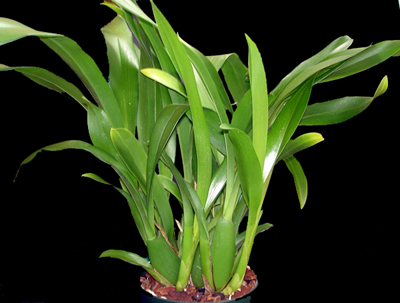
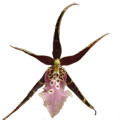 Miltassia is an intergeneric orchid, Miltonia crossed with Brassia. Intricate bloom colors and patterns from the Miltonia side crossed with the spidery nature and scents of Brassia make for some unusually beautiful flowers. Care is similar to Oncidiums. Repot as new growth forms in a fine grade mix.
Miltassia is an intergeneric orchid, Miltonia crossed with Brassia. Intricate bloom colors and patterns from the Miltonia side crossed with the spidery nature and scents of Brassia make for some unusually beautiful flowers. Care is similar to Oncidiums. Repot as new growth forms in a fine grade mix.
Oncidium
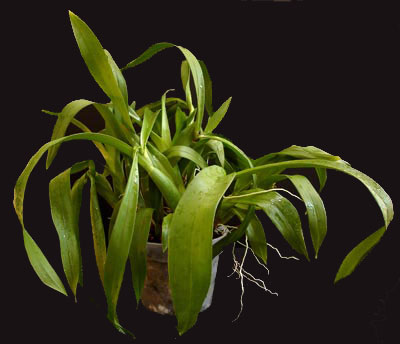
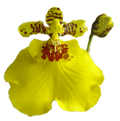 The Dancing Lady orchid delights with brilliant sprays packed with flowers. Yellow, tricolor, or the popular red sharry baby (that smells like chocolate), these are orchids easy to grow. Oncidiums have a habit of growing up and out of the pot as though they are trying to grow up a tree trunk. Oncidiums like to be evenly moist and if subjected to periods of dryness will grow leaves that have an "accordion" look to them. One option is to layer a bit of sphagnum moss on top of the media to increase humidity, just be careful that it is below the level of the pseudobulbs. Gallery Photo
The Dancing Lady orchid delights with brilliant sprays packed with flowers. Yellow, tricolor, or the popular red sharry baby (that smells like chocolate), these are orchids easy to grow. Oncidiums have a habit of growing up and out of the pot as though they are trying to grow up a tree trunk. Oncidiums like to be evenly moist and if subjected to periods of dryness will grow leaves that have an "accordion" look to them. One option is to layer a bit of sphagnum moss on top of the media to increase humidity, just be careful that it is below the level of the pseudobulbs. Gallery Photo
Miniature Oncidium

 Miniature Oncidiums, the most popular being Oncidium Twinkle, have a remarkable number of flowers for such a small plant.
Miniature Oncidiums, the most popular being Oncidium Twinkle, have a remarkable number of flowers for such a small plant.
Miniature Oncidiums prefer to be in a small, tight pot and will dry out very quickly. It is a bit of a challenge keeping these little guys moist enough. Still, they are relatively easy to grow and have a generous bloom. Unlike standard Oncidiums, the miniature varieties are less likely to attempt to grow up and out of the pot.
These are diminutive plants, usually 6 inches or less in height.
Recommended Miniature Oncidium Potting Mix:Phaius
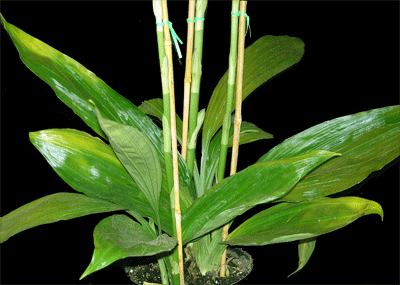
 The "Nun Orchid" or "Nun's Cap Orchid" is a beautiful broad leaf terrestrial orchid of the genus Phaius. This orchid can grow outside year-round in freeze-free areas. In colder climates this orchid enjoys summers outside and should come indoors before night temperatures drop below 40 degrees. In winter it will develop tall bloom stems topped with many beautiful blooms.
The "Nun Orchid" or "Nun's Cap Orchid" is a beautiful broad leaf terrestrial orchid of the genus Phaius. This orchid can grow outside year-round in freeze-free areas. In colder climates this orchid enjoys summers outside and should come indoors before night temperatures drop below 40 degrees. In winter it will develop tall bloom stems topped with many beautiful blooms.
Terrestrial Classic Orchid Mix Orchid Mix
Paphiopedilum

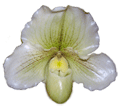 The Lady Slipper orchid holds a special appeal for many orchid growers. Terrestrial in nature, Paphiopedilums grow in the loamy detritus on the jungle floor. Paphs have been called the "ultimate houseplant" for their ease of growth in the home. The new growth on a Paph consists of a "fan" of new leaves that emerges from the base of the previous fan. There is no pseudobulb and therefore Paphs have no water reservoir to fall back on during dry times. As a result, the paph grower tries to keep a delicate balance between keeping the plant moist enough yet not too moist. Potting media made especially for Paphs can help maintain this balance. Gallery Photo
The Lady Slipper orchid holds a special appeal for many orchid growers. Terrestrial in nature, Paphiopedilums grow in the loamy detritus on the jungle floor. Paphs have been called the "ultimate houseplant" for their ease of growth in the home. The new growth on a Paph consists of a "fan" of new leaves that emerges from the base of the previous fan. There is no pseudobulb and therefore Paphs have no water reservoir to fall back on during dry times. As a result, the paph grower tries to keep a delicate balance between keeping the plant moist enough yet not too moist. Potting media made especially for Paphs can help maintain this balance. Gallery Photo
Phalaenopsis
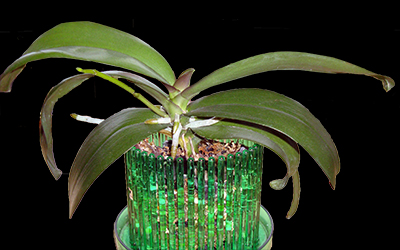
 The Moth orchid is the most common orchid due to its ease of production and the ability to force it to bloom year-round. Phals are easily grown in the home and stay in bloom for a very long time. A mature phal will be in bloom much of the year with graceful inflorescences loaded with good-sized blooms. From pure whites to unusual spotted harlequins, phals are sure to please. Gallery Photo
The Moth orchid is the most common orchid due to its ease of production and the ability to force it to bloom year-round. Phals are easily grown in the home and stay in bloom for a very long time. A mature phal will be in bloom much of the year with graceful inflorescences loaded with good-sized blooms. From pure whites to unusual spotted harlequins, phals are sure to please. Gallery Photo
- Phalaenopsis Monterey Gold Imperial Orchid Mix
- Phalaenopsis Monterey Dark Imperial Orchid Mix
- Phalaenopsis Gold Classic Orchid Mix
- Phalaenopsis Dark Classic Orchid Mix
- Phalaenopsis AAA Imperial Orchid Mix
Phragmipedium
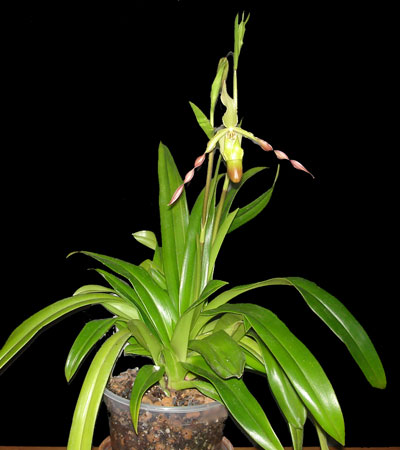
 Phragmipedium love water. In fact, they love water so much that they prefer to continually have 'wet feet'. This is in stark contrast to the vast majority of other orchids. Many of these orchids live along the splash zone of streams in nature. The bloom of the phragmipedium is very similar to that of the Paphiopedilum and resembles a lady's slipper. Offspring of Phrag. besseae bear brilliant reds not found in other ladyslipper orchids.
Phragmipedium love water. In fact, they love water so much that they prefer to continually have 'wet feet'. This is in stark contrast to the vast majority of other orchids. Many of these orchids live along the splash zone of streams in nature. The bloom of the phragmipedium is very similar to that of the Paphiopedilum and resembles a lady's slipper. Offspring of Phrag. besseae bear brilliant reds not found in other ladyslipper orchids.
Psychopsis

 The Butterfly orchid (Oncidium Papilio) is a unique and fanciful orchid with attractive foliage and blooms atop very tall spikes that look like butterflies dancing in the breeze. Blooms are born sequentially on the same spike for many months. Psychopsis are relatively easy to grow in the home and seem to tolerate a range of light conditions quite well. They can be fussy about repotting yet don't like to grow in broken down or sour mix either. Repot only as new growths appear. Gallery Photo
The Butterfly orchid (Oncidium Papilio) is a unique and fanciful orchid with attractive foliage and blooms atop very tall spikes that look like butterflies dancing in the breeze. Blooms are born sequentially on the same spike for many months. Psychopsis are relatively easy to grow in the home and seem to tolerate a range of light conditions quite well. They can be fussy about repotting yet don't like to grow in broken down or sour mix either. Repot only as new growths appear. Gallery Photo
Sarcochilus
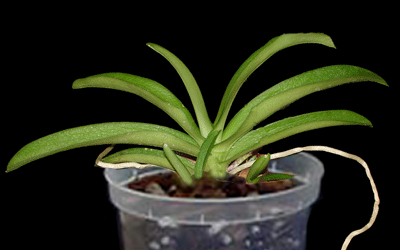
 The Sarcochilus is a wonderful miniature orchid native to Australia. Most are lithophytes and like moist conditions without drying out yet they don't like 'wet feet'. They can be grown successfully in conditions ranging from those for Phalaenopsis to Cattleya. Sarcochilus is a monopodial orchid, like its close relative the Phalaenopsis. These little orchids freely grow new clumps and bloom profusely in the spring.
The Sarcochilus is a wonderful miniature orchid native to Australia. Most are lithophytes and like moist conditions without drying out yet they don't like 'wet feet'. They can be grown successfully in conditions ranging from those for Phalaenopsis to Cattleya. Sarcochilus is a monopodial orchid, like its close relative the Phalaenopsis. These little orchids freely grow new clumps and bloom profusely in the spring.
Vanda
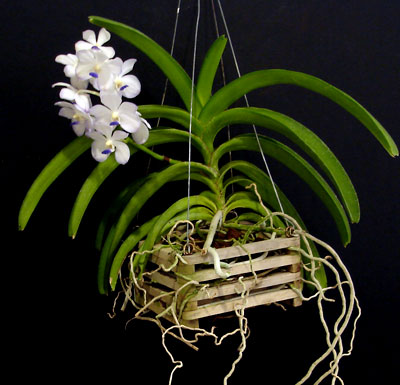
 The Vanda is a delightful and unique orchid to grow. Unlike many other orchids, Vandas are most often seen growing in baskets with their roots hanging down in mid air. Vandas can be a bit of a challenge to grow in the home because of their high light and high humidity requirements. Given favorable conditions, Vandas will bloom a few times per year. Vandas grow either alone in a Vanda Basket or in a basket with Large Coconut Husk Chips or
Chunky Cattleya Blend to provide additional moisture and humidity. For stability within the basket, Coconut Husk Fiber and Large Cork Chunks are excellent choices.
Gallery Photo
The Vanda is a delightful and unique orchid to grow. Unlike many other orchids, Vandas are most often seen growing in baskets with their roots hanging down in mid air. Vandas can be a bit of a challenge to grow in the home because of their high light and high humidity requirements. Given favorable conditions, Vandas will bloom a few times per year. Vandas grow either alone in a Vanda Basket or in a basket with Large Coconut Husk Chips or
Chunky Cattleya Blend to provide additional moisture and humidity. For stability within the basket, Coconut Husk Fiber and Large Cork Chunks are excellent choices.
Gallery Photo
